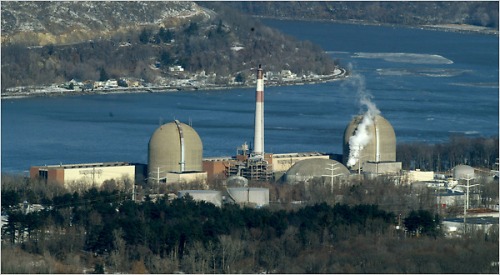By Roger Witherspoon
For the past 23 years, Entergy engineers have tried unsuccessfully to ignore, live with, and then stop a radioactive rain from the Indian Point 2 reactor cavity from falling onto workers inside the massive containment building.
And after decades of ignoring the problem and having workers wear raincoats and rain hats to prevent radioactive contamination from the indoor precipitation, Entergy pledged in 2010 to try different methods in each of the next three refueling outages to see if they could stop the flow of water through the massive concrete and steel tub surrounding the reactor. That six-year plan was deemed acceptable by the NRC.
But Entergy’s efforts during the first two refueling outages failed. The plant is currently in the midst of the third refueling outage and NRC spokesman Neil Sheehan said in an email exchange that the company has been unable to find or halt the leaks.
“Entergy is still working on a solution to the problem of leakage from the Unit 2 refueling cavity,” Sheehan wrote. “Thus far, the leakage has not yet been halted. But it’s important to note that leakage is captured in the containment building sump and then processed in the plant’s radioactive water cleanup system.
“We had a metallurgical specialist at the site this week to observe Unit 2 refueling activities. As part of his inspection, he reviewed the work on the refueling cavity. The results of that review will be documented in an upcoming inspection report.”
The steady drip of about 10 gallons per minute comes through the specially designed, concrete, waterproof cavity which surrounds the reactor and is filled with water in order for refueling to take place. Exposure to the reactor core would kill anyone in the area, so the cavity extends more than 30 feet above the reactor itself. When filled, the reactor head can be removed remotely and the 12-foot long fuel rods lifted out and transported on an underwater train through a flooded canal to the spent fuel pool in an adjacent building. ( http://bit.ly/1SasOhH )
According to Entergy’s July, 2001 Final Safety Analysis Report ( FSAR ) for Indian Point 2, which was submitted to the NRC and is a matter of public record, “The floor and walls of the canal are concrete, with wall and shielding water providing the equivalent of 6-ft of concrete.
“The refueling canal floor is 5-ft thick. The concrete walls and floor are lined with 0.25-in. thick stainless steel plate. The linings provide a leakproof membrane that is resistant to abrasion and damage during fuel handling operation” ( http://bit.ly/1Q617nX ).
But the FSAR, which was accepted by the NRC and the resident inspectors at Indian Point 2, came eight years after the 1993 discovery that reactor coolant was flowing unchecked through undetected leaks in the concrete and falling on workers in the rooms below at rates up to 10 gallons per minute. That was when Entergy first entered the leak into its “corrective action program” as an issue to be thoroughly examined and corrected. The coolant is radioactive, containing both tritium and a basket of isotopes from the 100 tons of irradiated fuel rods taken from the reactor.
At this decades-long leak rate, more than 4.6 million gallons of radioactive rain has fallen through the reactor cavity and transfer canal onto the work area below.

The reactor coolant also has high concentrations of boron, which is used to absorb neutrons and stifle the fission process. If borated water is not contained, the water will eventually evaporate and can leave a crystallized pile of boric acid in its wake. This is capable of corroding and eating through the carbon steel supports around the reactor, as well as the stainless steel lining of the reactor cavity and fuel transfer canal. It was boric acid, long ignored by FirstEnergy, which resulted in a football-sized cavity developing in the head of the reactor at the Davis Besse nuclear power plant in Ohio. To what extent accumulating boric acid may affect the integrity of various carbon steel supports in the reactor building is unknown.

David Lochbaum
David Lochbaum, nuclear safety engineer with the Union of Concerned Scientists, pointed out the similarities between this ongoing leak and the lack of oversight at Davis Besse in a July, 2010 letter to William Borchardt, then the NRC’s Executive Director for Operations. At the time, Entergy was planning another refueling outage at Indian Point 2 though there had been no change in the leak and no assessment of its impact of steel structures.
Lochbaum noted in that letter, “it would be replicating the inadequate licensee management and ineffective regulatory oversight factoring into the Davis Besse near-miss to conduct another refueling outage at IP-2 the way outages have been conducted since 1993…
“According to the NRC’s inspection report, refueling cavity leak rates of between 2 and 10 gallons per minute have been repeatedly entered in the corrective action program dating back to 1993. Despite these numerous corrective action program entries, the licensee has not yet evaluated the impact of reactor refueling cavity water leakage on the dissimilar metal welds between the stainless steel liner and the carbon steel studs, nor has the licensee evaluated the effects of the leakage with regard to liner attachment welds and carbon steel hardware.”
No Big Deal
In reply ( http://bit.ly/1TXUpIr ), Borchardt wrote in July 2010 that “Indian Point Unit 2 refueling cavity leakage occurs for about two weeks every two years during refueling activities, then the refueling cavity is drained and the leak stops…In addition, the refueling cavity liner serves no function when the plant is operating at power.”
In Borchardt’s view, the unplanned and uncontrolled leaks were an inappropriate annoyance during refueling, but not a threat to the integrity of the reactor or any safety systems.
“From our reviews,” he wrote “we determined that Entergy’s plans related to repairing the leak and monitoring plant components for age-related degradation are acceptable. As part of the license renewal process, the NRC’s independent advisory body, the Advisory Committee on Reactor Safeguards, considered this leakage condition in its review of the staff’s safety evaluation report and agreed that the condition is not one which would preclude granting a renewed license for Indian Point Unit 2.”
That assertion by Borchardt came nine years after Entergy’s 2001 evaluation report claiming the reactor cavity and canal were “leakproof,” and in the midst of an ongoing challenge by the New York Attorney General’s office to relicensing the plants partly on the grounds that its long-term ageing management plans were not reliable.
Entergy has been seeking 20 year extensions on the licenses of the twin reactors, which are now more than 40 years old, since 2007. The license for Indian Point 2 expired in 2013, and the license for Indian Point 3 expired last year. They are currently allowed to operate by the NRC until the licensing process is complete. The NRC is actively seeking to relicense all of the nation’s 100 reactors, and has so far granted extensions to about 75. The license review process for all other reactors has taken an average of two years.

NY Attorney General Eric Schneiderman
The extensions for both Indian Point plants, however, are being challenged by the environmental groups Riverkeeper and Clearwater, and the State of New York on several grounds, including contentions that the ageing management process for the plants’ critical components is flawed and unreliable. Last month, for example, Entergy relented after more than five years of legal wrangling and agreed to inspect the lining of the reactor – something that is not required by NRC regulations but has been pushed by New York Attorney General Eric Schneiderman. That inspection found that more than 27% of the bolts used to hold the lining of the reactor and channel coolant through the fuel rods had degraded in the hot, radioactive environment and were broken or missing ( http://bit.ly/1RMDiCM ). Entergy declined to discuss this issue.
The indoor leaks at Indian Point stem from a grave miscalculation made when the nation’s nuclear plants were designed in the 50s and 60s. It was assumed, explained Lochbaum, that pipes and concrete conduits wouldn’t break down over time and that concrete, though porous, was certainly unlikely to leak in the two weeks to a month needed for refueling and reactor maintenance.
“Many plants have had a problem like this,” Lochbaum said. “In the mid-80s at 9 Mile Point reactor in upstate, New York, they were leaking so much water that they ran out of tanks to store it in. So they decided to use the basement of the containment building and just poured the water in.
“But they forgot that there were 55-gallon drums filled with radioactive trash stored down there, and these fell over and dumped their contents all over. The NRC didn’t find out about it until a story came out a year later – the resident inspectors never looked down there.”

Inspectors did not check to see if Entergy was fixing the leak at Indian Point 2, either. The company annually entered the leaks into its corrective action file, and then did nothing.
The NRC didn’t get involved again with the radioactive rainfall until 2008. “At Indian Point,” Lochbaum stated, “you have a seismic issue. The only reason that there is a stainless steel liner in the reactor well is to guard against leakage in case of an earthquake.” There are two seismic fault lines under the 239-acre Indian Point campus.
“In 08,” he continued, “one of the NRC inspectors found workers wearing raincoats in the containment building. When he asked why they were wearing them indoors they said it was because the liner was leaking so badly that it was raining in the room below it and they didn’t want to be contaminated by the radioactive rain.”
But pinpointing small leaks is difficult. The reactor, transport canal and spent fuel pool have liquids added and removed for a variety of reasons, including normal evaporation, filtration, and various siphons to test the composition of the water for radioactive particulates. Finding particulates would indicate that a fuel rod or group of rods had cracked and pieces of irradiated fuel were swirling in the water.
“We are so focused on finding and fixing the big leaks and big accidents,” lamented Lochbaum, “that when there are slow drips over a long period of time we don’t react very well. The leak in 1993 was annoying, and the next time there was an outage it was still annoying – but they felt they didn’t need to fix it. They just lived with it.”
That kind of corporate conduct was termed “normalization of deviance” by Columbia University psychologist Diane Vaughan in her book “The Challenger Launch Decision.” She has defined it as a situation where “people within the organization become so much accustomed to a deviant behavior that they don’t consider it as deviant, despite the fact that they far exceed their own rules for the elementary safety.”
She applied that description to the Space Shuttle Challenger, which had a flaw in the booster motors which was ignored since it hadn’t affected a dozen flights. On the 13th flight, the Challenger blew up, killing the crew.
While the leaks at Indian Point 2 occur only during refueling outages, the canal and the ability to flood the reactor cavity so the reactor and its fuel can be thoroughly inspected is part of the safety system for the reactor in the wake of an earthquake. Workers would have to count on the integrity of the reactor cavity and the canal to safely remove the dangerous, irradiated fuel.
But, asked Lochbaum, if the reactor cavity liner is cracked and leaking before an earthquake, in violation of existing license requirements, “it is virtually impossible for this safety-related function to be satisfied after a seismic event. It seems more likely that the forces applied during the seismic event could significantly increase the pre-existing leak rate.”
Furthermore, he said, if it has been leaking unchecked for decades, there is no way to know for certain if it will continue that way, or if it will reach its stress limit and suddenly break while the reactor is open and the fuel exposed.
“Indian Point 2 has been flying blind during refueling outages conducted since 1993,” said Lochbaum.
This story I have just read, which I take to be true, is very disappointing.
I recall hearing a number of years ago that ground water monitoring wells showed increased readings at the Indian Point site after a refueling outage was held at one of the plants there. (I do not remember which.) When they started looking at the area which is flooded up during refueling, I was told that they had found a very small leak. I did not associate at the time that if the leak was inside the containment building, and the monitoring wells were outside the containment building, that, apparently, that containment building ALSO had a leak in it. The question would be: doe it still?
At Nine Mile Point, Unit One, the flooded room was at the bottom of the Rad Waste Building and was still flooded, but being emptied in the early 1980s. I should mention that, in those days before Dr, Shirley A. Jackson and “risk-informed” everything, there were black and white rules to be followed and actual monetary fines as Enforcement Actions, not simply, Alternate Dispute Resolution.
By: Tom Gurdziel on April 18, 2016
at 9:03 pm
It is still leaking, Mr. Gurdziel. There are some 3 miles of inaccessible, underground piping, which makes it difficult to pinpoint the exact source of leaks.
By: roger6t6 on July 18, 2016
at 6:04 pm
The reactor cavity liner is not safety related and its installation has absolutely nothing to do with potential seismic activity. Most if not all plant’s reactor cavities are lined with stainless steel, even those 100’s and 1000’s of miles away from what local environmentalists would have you believe are the most active faults on earth. Further yet, boric acid does not corrode stainless steel. If you and Mr. Lochbaum slipped up on these facts, what else have you missed or gotten wrong? Maybe you should slip in some expert analysis from Marilyn Elie too…
By: Andy on April 20, 2016
at 11:12 pm
Thank you for the sensible critique. Me and my neighbor were just preparing to do a little research about this. We got a grab a book from our local library but I think I learned more from this post. I am very glad to see such fantastic info being shared freely out there.
By: Sammie Howerter on July 18, 2016
at 5:56 pm
Wow! Thank you! I constantly wanted to write on my website something like that. Can I include a fragment of your post to my site?
By: Alexis Chapen on August 2, 2016
at 9:44 pm
Yes
By: roger6t6 on August 3, 2016
at 1:35 am